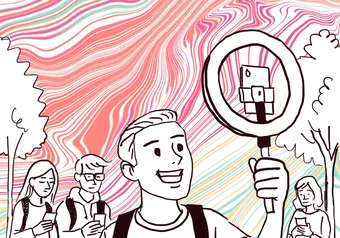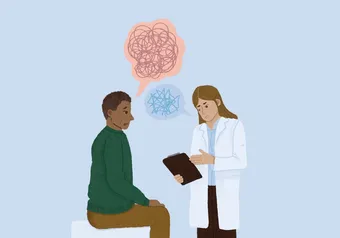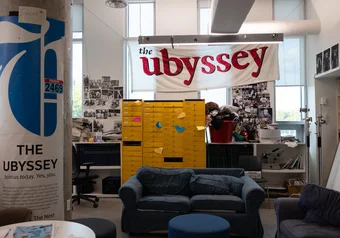Ada, the little robot, is in trouble.
Waves crash over her bow and lines cry out in the wind. A wave rises up behind Ada and she is carried up with it. For a moment, she sits at the peak of the wave, motionless in the heart of the violent Atlantic. The moment ends and she careens down its face, moving faster than she was ever designed to. The wave yanks at her rudder, straining it further and further to the side. Just as Ada is about to bottom out, there is a loud snap.
The rudder has failed.
Ada can’t steer.
She’s 8,500 kilometres from home, 14 days away from Europe, stranded and no one is coming to help her.
She’s on her own.
Taking the Atlantic
The UBC SailBot team designed and built Ada, a fully autonomous sailboat, known as a "sailbot." Ada is named after Ada Lovelace, who wrote the first computer program in the 1800s. The team is made up of about 60 UBC undergraduate students who work on Ada as volunteers.
In 2004, several UBC students, led by Erik Berzins, didn't want to build the human-powered submarine they were tasked with for their capstone project. They convinced their professor to let them start a design team and built a sailboat instead. The club competed in its first competition in 2006.
Several years later, a group of young engineers — known as the Original Team — picked up the mantle of UBC SailBot. The Original Team, composed of Kristoffer Vik Hansen, Neil Dobie, David Lee, Adrian Granchelli, Karry Ocean, Dave Tiessen, Michael Schnetzler, Greg Wong and Josh Andrews, among others, took the previously designed boat and gave it a major facelift to compete in the International Robotic Sailing Competition in 2012 — a competition that was inspired by the success of the capstone project.
The UBC team won the event in 2012 and in 2013, when they became the first to earn a perfect score. They released most of their design so that other teams could learn from it to improve their boats and level the playing field. They returned to the competition in 2014 with the same boat they had used in 2013 and won the competition.
“That was our signal that we are in a league of our own and this competition was too small for us,” said Youssef Basha, a graduating electrical engineer who has spent the last four years with UBC SailBot. “So we decided we were going to take the Atlantic.”
Don Martin, a Vancouver based yacht designer and advisor to the SailBot team, helped the team design Ada’s hull — but he played a much larger role in Ada’s life than just the design.
In 2013, Martin and Hansen had a conversation after winning their second competition in a row with a perfect score — they needed a bigger challenge. The two came up with the idea to cross the Atlantic and the idea for Ada was born.
By late 2013, UBC SailBot had been throwing around the idea of ditching competitions to focus on the Atlantic for a while. An email thread solidified the idea and the team got back to work.
The competition boat — TB2013 — was only two metres long. The team would need a bigger boat. While the team could use what they learned from competing and apply it to Ada, the boat needed a massive upgrade if it was going to make a transatlantic journey.
Getting to work
It’s the fall semester of 2013 and SailBot has just committed to crossing the Atlantic — 100 per cent autonomously.
No one on the team has ever sailed across the Atlantic — the journey is a black hole. The challenges that face them remain a mystery. With no idea of the hardships their boat will face crossing the ocean, the engineers are at a loss of where to start.
The leaves have just started to fall on campus and the winter rains have yet to set in. The sun is setting behind the Engineering Design Centre as 70 undergraduate engineers file into the building after their last Monday lecture. The team piles into the centre, grabbing a seat in front of a projector. Hansen, the team captain at the time, starts a presentation on the team’s progress and what needs to be done next.
Over the next three years, the team will spend every Monday evening at team meetings and every Saturday at the Rusty Hut, the engineering workshop, at subteam work parties. They will be meeting with and interviewing sailors, engineers, boat designers, teachers and adventurers to learn everything they can about sailing, sailboats and the the open ocean.
[Sorry, video not found. You can contact webmaster@ubyssey.ca to fix the issue]
The task at hand
UBC SailBot, which fluctuates between 60 and 70 undergrad members depending on the year, is broken up into three subteams. Each of the three subteams — mechanical, electrical and software — tackled one aspect of Ada. The team captain oversees all three subteams. The mechanical team was tasked with, among other things, designing and building the hull and sail. The electrical team is responsible for sensors and power. The software team write Ada’s brain — coding her how to steer, navigate and sail.
The teams work independently much of the time, but are in constant communication. Ada isn’t a hull, a sensor and some code — three stacks of technology. She is one integrated, intelligent and sophisticated robotic sailbot with a life of her own. She needs to be 100 per cent autonomous. The team puts her in the water, tells her where to sail and lets her go — no remote control, instructions or humans on board.
I kissed a girl and I liked it
On Saturdays, the team would arrive at Rusty Hut at 9 a.m., trudging through the cold autumn rain to meet with their subteams. About 15 to 20 team members fill the workspace until 1 p.m., when the second crew came to replace them. The second team worked until 5 p.m. — sometimes late into the night.
The first few months saw members gathering around tables, laptops illuminating their faces. Before the team can build anything, they must first research and design the vessel.
By early 2014, the Rusty Hut is bustling with the sounds of construction, forcing the software team to flee and find refuge in the quieter Design Centre.
The mechanical team, lead by Neil Dobie and Dave Tiessen, began with the hull. Not only would the hull have to be completed first so that the rest of Ada can be built onto it, they would only have one shot at building it. Since electronics, sensors, batteries and the rest of the mechanical parts will be placed in and on the hull, once it’s done, it’s done.
While five or so engineers huddled around the hull, sanding its edges to perfection, a team of five electrical members clustered over a table at the side of the workshop — fiddling with a sensor or battery. The team was tasked with providing power to Ada, the hardware of her brain and all of the sensors to guide her on the 3,300 kilometre crossing.
A few members of the team worked in the office in the Rusty Hut, continuing to research and design for the adventure ahead.
Down the street, the software subteam pushed together a group of tables and set to typing, building Ada’s intelligence one line of code at a time. The subteam is dependent on the hardware the mechanical and electrical teams install on the boat, and must work on code for functions Ada may never have. Members of the team devote thousands of hours into code that could get cut hours before launch.
At this point, the team is still over a year and a half away from launch, but they are hard at work to the ritualistic soundtrack of movie scores, Taylor Swift, Katy Perry and Imagine Dragons. The music floats out of the Rusty Hut and into the Vancouver drizzle.
When Youssef Basha says, “The hull was built half to war music and half to ‘I Kissed a Girl,’” it’s no joke.
Literally our life
The team that built Ada would spend a lot of time together, working on their boat. Weekly group meetings, all-day Saturday work parties and a summer of near-constant labour built the team into a family.
“SailBot was literally our life this summer,” said Madie Melcer, a 3.5 year (yes, that’s a thing) mechanical engineer. “You can’t not make friends.”
“The only time I had to myself was when I was sleeping,” said Vivian Cheung, a recent UBC graduate who spent two and a half years with SailBot. Cheung is described as team “mother” and this summer — while the team was making their final push to finish Ada — organized the testing, the trip to Newfoundland and team lunches and dinners.
While the team was — and is — very much a family, they also had a boat to build. Josh Baker, a fifth-year computer engineer and a core member of Ada’s software team, remembers when shortly after joining the team, he would pitch ideas to Josh Andrews, the software lead at the time, only to have Andrews explain how “crazy the idea was.”
Andrews would stress to the software team how they needed to keep Ada as simple as possible. The team is composed of students — complicated design would lead to poor execution. Baker said the idea stuck and runs through much of Ada’s design.
“We’d throw out ideas, and we’d go back and try and tear down every assumption we had,” said Basha, the team’s ‘hardware hero.’ “Reductio ad absurdum.”
But the constant, constructive criticism only brought the team closer together — Josh Baker is going to Josh Andrews's wedding later this year.
Overdrive
With only a few months left to finish Ada before the Atlantic crossing, SailBot went into overdrive this summer. Some team members, like Cheung, were working full-time on Ada. They would show up at the Kitsilano Yacht Club at 9 a.m., test Ada on the water for four or five hours, do the required adjustments and corrections back on land, and head home to do more work or catch some sleep when the yacht club closed for the night.
Other team members, like Baker and Melcer, would work full-time jobs or on co-op during the summer, and use their lunch breaks and after work hours to sink 20 to 40 hours of work into Ada.
It was July 20 when the team disassembled Ada, packed her into a trailer with all of their tools from the Rusty Hut and started the engine on Elliot — an old suburban — and a second car, Millie (seriously, what’s with all the names?). Ten members of the team would spend the next 10 days driving across Canada to Newfoundland, camping along the way.
Cheung was in Elliot, with five guys from the team. Elliot is old and the lack of air conditioning, “was awful,” said Cheung. When the team left Vancouver for their 7,500 kilometre road trip, the high for the day was 24ºC.
The team worked their way across the country, spending their days listening to music (not the Rusty Hut playlists) and podcasts, and their nights in campgrounds — dreaming of Ada sailing the Atlantic.
The team would arrive in St. John's, Newfoundland on July 29 and get to work. Ada would launch on August 24, and the team had a lot to do before then. First, in a workshop at Memorial University, the team would rebuild Ada — she was gutted for the cross-country trip. Then they would return to testing — this time, they weren't limited by a yacht club’s hours. Working off of a private dock in the Atlantic Ocean, the team would test Ada for 14 to 16 hours a day. Some nights they'd be on the dock until the early morning.
The team, which grew as members flew in, would work for as long as they could before grabbing a few hours of sleep in an Airbnb they had taken over and covered in sleeping bags. When the Newfoundland team slept, the team in Vancouver — including Baker — would get to work writing code for the Newfoundland team to test the next morning. Arek Sredzki, the software lead who spent his summer in Montreal, slept in his office — unwilling to give up precious time commuting, working every moment he has.
[Sorry, video not found. You can contact webmaster@ubyssey.ca to fix the issue]
Robot nightmares
The team has Slack, a work messaging app, with a channel called #nosleep. The rules of the channel are simple. One, you may only post “not sleeping” in the channel. Two, it must be after 1 a.m. Messages were regularly posted in the channel early into the morning — sometimes as early as 7 or 8 a.m. — when team members have yet to sleep.
The clock was ticking, and the pressure was on and it got to the team. The sailbot nightmares began.
Basha remembers waking up to beeps of a warning system of Ada, thinking he had fallen asleep on the dock and something was wrong. Ian Kellough-Pollock, whose sleeping bag was next to Basha’s, had nightmares about the same system — which had been giving them problems all summer — muttering “No, the… it’s just not… I can’t…” in his sleep.
The night before launch, the team hit one final roadblock — the infrared obstacle avoidance system had failed, causing a critical problem on-board. With four hours to go, the team decided to cut the system, saving the boat. Several members were integral to the system but one, Denis Trailin, had worked almost exclusively on the system for a year. There was no time to mourn.
After averting that crisis, the team — which only had eight members left in Newfoundland, as the rest had flown home or started the drive back to campus as to not miss the first day of class — boarded The Inquisitor (definitely the best name yet), a tugboat they were given access to to pull Ada out to sea.
Then Ada was off.
The team cried, Facetimed team members across the country and headed to shore.
The hardest 20 minutes of your life
For the next four days, the team was glued to Slack, which received a heartbeat — data on Ada’s location and health — every 20 minutes. Then the team received a heartbeat that Ada was headed south — the wrong direction. It wasn’t a big deal — sometimes Ada did funny things. Then they received a second heartbeat — Ada was still moving south. Then a third.
“It’s the hardest 20 minutes of your life,” said Basha.
On the other side of the Atlantic — in London — Cheung and team member Cody Smith had received the same message. It was 4 a.m. and the two decided they needed to sleep — Ada was probably just acting funny like she sometimes did.
The next morning they woke up and Ada was still moving south. The team called it — Ada was done.
Cheung and Smith opened a bottle of red wine, first thing in the morning, and poured themselves a glass.
It is impossible to know exactly what, or how, Ada broke until the team recovers the boat but they believe the rudder — or the linkage to the rudder — broke. Without a rudder, Ada can't steer and can only float with the wind and ocean currents.
“We never felt like we failed. Getting this far is a huge feat on its own. We built something so many people had personally connected with,” said Basha. “We say Ada, we refer to her as a she, people refer to her as a she. She’s not a robot anymore…”
“She’s a person,” said Melcer, finishing his sentence.
“She’s part of the team as much as we are — she’s our baby,” said Basha.
The team is going to take everything they learned from Ada 1.0 and apply it to Ada 2.0, or Babbage (after Charles Babbage, a mathematician) – the name is a work in progress. SailBot isn’t going to try to cross the Atlantic again — at least, not yet. But that doesn’t mean they are shooting for an easier goal. The plan is to enter the Vic Maui Race — a manned sailboat race from Victoria, BC to Maui, Hawaii. The new boat will race 4,000 kilometres across the Pacific against human teams.
The next Vic Maui is in July 2018, giving the team just over 600 days to finish the new boat. They’ll take design elements and ideas from Ada 1.0, but the new boat will have to be built from scratch
“The fact that so many people had such a genuine, emotional connection with a machine is our biggest accomplishment,” said Basha.
Since the team received the devastating news of Ada's injury, she has slowly floated across the Atlantic, inching closer to Europe. If you are a ship captain in Portugal, hit SailBot up — they want their baby back.
Correction: An earlier version of this article did not include several members of the Original Team. The Ubyssey regrets this error.
First online
Share this article



![['']](https://storage.googleapis.com/ubyssey/media/renditions/storm.width-1000.format-webp.webp)
![['']](https://storage.googleapis.com/ubyssey/media/renditions/ADA_koby_michaels_1_of_4.width-1000.format-webp.webp)

![['']](https://storage.googleapis.com/ubyssey/media/renditions/ADA_koby_michaels_2_of_4.width-1000.format-webp.webp)
![['']](https://storage.googleapis.com/ubyssey/media/renditions/ADA_koby_michaels_4_of_4.width-1000.format-webp.webp)
![['']](https://storage.googleapis.com/ubyssey/media/renditions/ADA_koby_michaels_3_of_1.width-1000.format-webp.webp)





